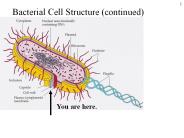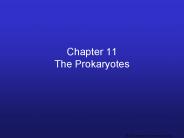Myxobacteria PowerPoint PPT Presentations
All Time
Recommended
Hypothesis: Slime secretion from the nozzle-like structures may provide the ... This is consistent with the force predicted to be generated by slime extrusion. ...
| PowerPoint PPT presentation | free to view
Life cycle of Myxobacteria (Dale Kaiser, 2003 ) C-signal level controls the ... reversal clock, and verifies the 'refractory period' during the decreasing stage ...
| PowerPoint PPT presentation | free to view
A Possible Mechanism of Repressing Cheating Mutants in Myxobacteria Winfried Just and Ying Xiao, Department of Mathematics, Ohio University This work was inspired by ...
| PowerPoint PPT presentation | free to download
e) experimental photo of M. xanhtus fruiting bodies in a side view (10X magnification) ... 4. Provide a forum for junior faculty and graduate students to ...
| PowerPoint PPT presentation | free to view
Bacillus sporulation. Myxobacteria fruiting. Anabaena heterocysts. Caulobacter cell cycle ... Signal. transduction. Bacillus, Anabaena, Myxococcus. Pathogens ...
| PowerPoint PPT presentation | free to download
From Signal Transduction to Spatial Pattern Formation in E. Coli: A ... Examples: spatial pattern formation in E. Coli and Myxobacteria, formation of biofilms ...
| PowerPoint PPT presentation | free to view
Kyle Biehl is a molecular biologist with an interest in genetics and genomics. He has worked to develop new methods for identifying and analyzing DNA sequences, as well as developing tools for identifying genetic variants. Kyle's first research experience occurred when he was in high school and assisted in a study at Colorado State University.
| PowerPoint PPT presentation | free to download
A natural product is a 'product (molecule) that is derived from ... For decades, natural products have been a wellspring of drugs ... the freezer overnight. ...
| PowerPoint PPT presentation | free to view
Nitrogen Fixing Bacteria Azotobacter, Beijerinckia Nitrogenase is oxygen sensitive Cysts, capsule, and poly- -hydroxybuytrate Neisseria and Relatives Neisseria, ...
| PowerPoint PPT presentation | free to download
1,3-AZOLES. Reactivity towards E-files. Reaction with ... Mechanism taxol. Pilokarpin (Acetylkolin agonist) Glaukom. Isolert fra Pilocarpus jaborandi ...
| PowerPoint PPT presentation | free to view
Title: Effect of osmotic pressure on cells Author: DGILMORE Last modified by: Dr.s Gilmore Created Date: 1/24/2004 6:45:31 PM Document presentation format
| PowerPoint PPT presentation | free to download
Chapter 27 Prokaryotes and the Origins of Metabolic Diversity
| PowerPoint PPT presentation | free to view
(ens307)
| PowerPoint PPT presentation | free to download
rod shaped, Gram negative, lophotrichous. chemoheterotrophs. Pseudomonas ... Sulfolobus (hot springs of Yellowstone National Park) - oxidizes sulfur ...
| PowerPoint PPT presentation | free to view
Scientific American 'Bacteria as Multicellular Organisms' ... Sporulation and Formation of Dormant Cells. Exchange of Genetic Information. Mutation ...
| PowerPoint PPT presentation | free to view
Title: Effect of osmotic pressure on cells Author: DGILMORE Last modified by: DGILMORE Created Date: 1/24/2004 6:45:31 PM Document presentation format
| PowerPoint PPT presentation | free to download
PowerPoint Presentation
| PowerPoint PPT presentation | free to download
Ancient fossils 3.5 billion years b.p. Archetype for prokaryotic organisms. Phototrophs ... Mutualists (bacteria and host both benefit) Unicellular, colonial, ...
| PowerPoint PPT presentation | free to download
Prokaryotes and Protists Chapter 16
| PowerPoint PPT presentation | free to view
Staph lives on our skin. And sometimes it gets in. Making ... Staphylococcus aureus. Opportunistic pathogen: makes toxins. Skin abscesses. Food poisoning ...
| PowerPoint PPT presentation | free to view
Somersault = tumble. Random walk. Homogeneous environment; unbiased. CCW = smooth ... CW = tumble. Each flag. pushes in different direction. No bundles ...
| PowerPoint PPT presentation | free to view
Chapter 27 Prokaryotes Bacteria on the point of a pin
| PowerPoint PPT presentation | free to view
Objective To be able to describe the main features of bacterial cells and to understand the different nutritional and metabolic types. References
| PowerPoint PPT presentation | free to download
... (Extreme Halophile) (Methanogen)
| PowerPoint PPT presentation | free to download
... growth of competition when nutrients are in short supply Sporulation Resting cells Cells respond to low nutrients by sporulation or slowing down metabolic rate ...
| PowerPoint PPT presentation | free to download
... enzymes isolated the Asg E locus for ligation. Transformation and Ligation ... Ligation of Asg E gene with vector creates cosmid system for insertion into M. ...
| PowerPoint PPT presentation | free to view
Cell structure and function for microbiologists Prokaryotes Eukaryotes Both have the same types of biological molecules metabolism, protein synthesis, ATP
| PowerPoint PPT presentation | free to download
Both have the same types of biological molecules. metabolism, protein synthesis, ATP ... Lysosomes. Plasma membranes have different modifications. Cytoskeleton ...
| PowerPoint PPT presentation | free to view
Lecture 19' Microbial Diversity
| PowerPoint PPT presentation | free to view
... fischeri free-living the autoinducer is at low concentration and not luminescent. When they are highly concentrated in the photophore (about 1011 cells/ml) ...
| PowerPoint PPT presentation | free to view
Global control: modulons * Different operons/regulons affected by same environmental signal Presence of glucose Change from O2 to anaerobic growth
| PowerPoint PPT presentation | free to download
Diversity of prokaryotes (Chapter 11) In morphology In habitat In metabolism Basics of metabolism: energy source (of electrons, ultimately used for ATP synthesis)
| PowerPoint PPT presentation | free to view
Title: Unit 2. tools and techniques use in the study of Biology Last modified by: victor Created Date: 9/26/2006 2:20:16 AM Document presentation format
| PowerPoint PPT presentation | free to view
All possible habitats are exploited by some sort of prokaryote ... Actinomyces. Nocardia. Streptomyces. Actinomycetes. Figure 11.17. Gram-Negative Proteobacteria ...
| PowerPoint PPT presentation | free to view
... Iron-Oxidizing Bacteria: ex. Thiobacillus, Beggiatoa. Hydrogen-Oxidizing Bacteria: ... Oxidize H2S as an e- donor, but sulfur produced resides outside the cell. ...
| PowerPoint PPT presentation | free to view
... of Patupilone vs. Taxanes following single-dose administration to mice ... colonising nude mouse lung ... Untreated mice: brain tumors detectable day ...
| PowerPoint PPT presentation | free to view
Chick limb bud, after 3.5 days. Three-Dimensional Modeling of Morphogenesis 12 October 2004 ... cellmodel name= 'Chick' - useplugin name= 'Chemical' ...
| PowerPoint PPT presentation | free to view
Diversity of prokaryotes (Chapter 11) In morphology In habitat In metabolism Basics of metabolism: energy source (of electrons, ultimately used for ATP synthesis)
| PowerPoint PPT presentation | free to download
Similarity between Bchl g and Chlorophyll a (modified form of hydroxychlorophyll ... peach: Bchl b containing cells of Thiocapsa ...
| PowerPoint PPT presentation | free to view
Reproduction: Chemicals from the environment are converted into new cell ... Septum formation - Separation of two daughter cells. What are Bacteria? 1. ...
| PowerPoint PPT presentation | free to view
Chapter 11 The Prokaryotes Prokaryotic Taxonomy Prokaryotic genealogical tree Based on 16S ribosomal RNA Two domains Archaea Two phyla Bacteria 23 phyla Domain ...
| PowerPoint PPT presentation | free to download
Oxidize inorganic molecules like hydrogen gas (and produce what? ... oxidize ammonium, nitrite (nitrate is less. toxic, can be taken up by plants) ...
| PowerPoint PPT presentation | free to view
Quantum biology, water and living cells Eugen A. Preoteasa HH-NIPNE, LEPD (DFVM) nature is not sparing as for its structures, but only for its universally ...
| PowerPoint PPT presentation | free to download
Cell Communication For cells to function in a biological system, they must communicate with other cells and respond to their external environment.
| PowerPoint PPT presentation | free to view
Diversity of prokaryotes (Chapter 11) In morphology In habitat In metabolism Basics of metabolism: energy source (of electrons, ultimately used for ATP synthesis)
| PowerPoint PPT presentation | free to download
(convert hot, acidic gases into energy) Halophiles (convert salty water into ATP) ... 1) Rod-shaped are called Bacilli. 2) Sphere-shaped are called Cocci. ...
| PowerPoint PPT presentation | free to view
(Pharmaceutical Botany ) U117 0936776230 E.mail:horng@mail.tajen.edu.tw
| PowerPoint PPT presentation | free to view
This is based on direct comparison to known taxonomic groups. ... bacterium (Escherichia coli), an archaean (Methanococcus vannielii), and a ...
| PowerPoint PPT presentation | free to view
Live in extreme conditions. Mostly only hear about disease causing ... Methanogens use CO2 to oxidize H2 producing methane as a byproduct. Poisoned by oxygen ...
| PowerPoint PPT presentation | free to view
normal growth curve, with optimum environmental and nutritional conditions ... not all bacteria favor the same environmental conditions ...
| PowerPoint PPT presentation | free to view
imp mos in biotechnology industries
| PowerPoint PPT presentation | free to download
facultative or strict anaerobes. small amount of genetic material - 1/5 to 1/2 the normal ... facultative anaerobes and usually catalase positive ...
| PowerPoint PPT presentation | free to view
How I Spent My Spring Break
| PowerPoint PPT presentation | free to view
Potential Roles for Diatomists in Nanotechnology
| PowerPoint PPT presentation | free to view
Gram positive, flagellated rod. Produce endospores to survive harsh environmental periods ... Gram-negative, rod-shaped and flagellated ... Some Hot Springs Microbes ...
| PowerPoint PPT presentation | free to view
... PUBLIC '-//Apple Computer//DTD PLIST 1.0//EN' 'http://www.apple.com/DTDs/PropertyList-1.0.dtd' ... xmlns:stRef='http://ns.adobe.com/xap/1.0/sType/ResourceRef ...
| PowerPoint PPT presentation | free to view
























































